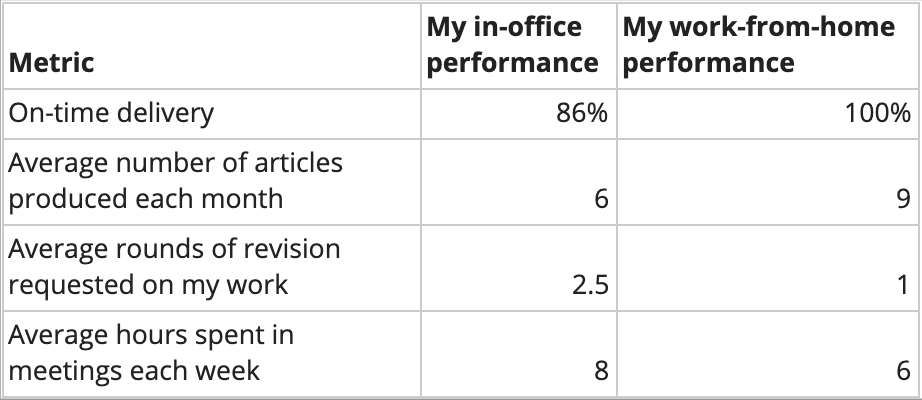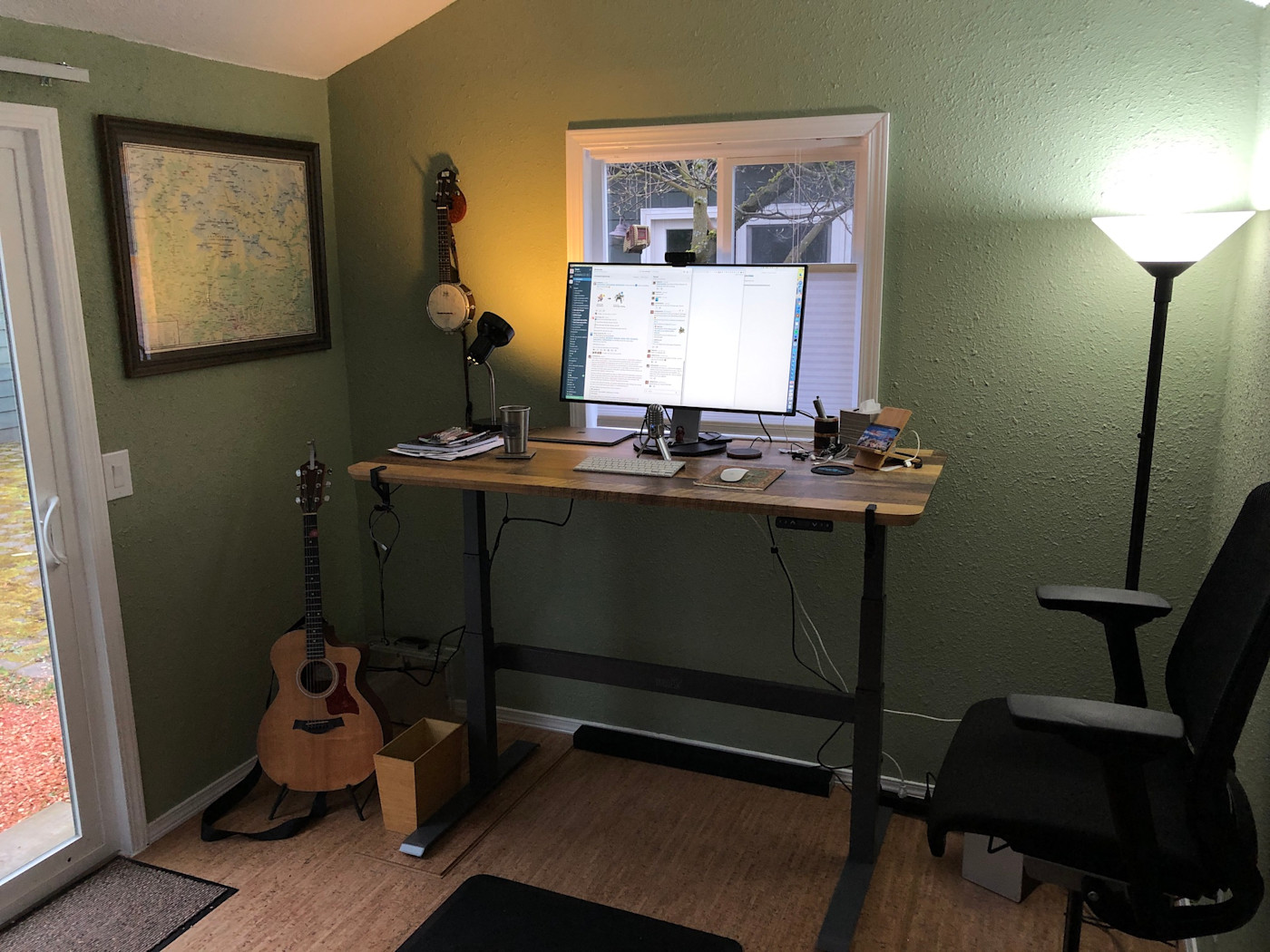Our recent work-from-home report showed that two-thirds of folks who were forced to work remotely would prefer to be in the office. But that leaves the remaining one-third who aren't looking forward to coworkers who chew loudly and don't understand the concept of inside voices. If you fall into that group, you might be considering asking your manager if you can continue to work remotely even once everyone else goes back to the office.
Some companies, including tech giants like Twitter, are adjusting their work-from-home policies. But others just won't. If your company doesn't plan on letting people continue to work remotely, you'll have to ask.
We've gathered some tips from managers, HR folks, and remote employees, on how to gracefully and, hopefully, successfully ask to work from home.
1. Be sure that you want to work remotely
If the rest of your colleagues will be going back to the office, it's not a small thing to ask if you can be an exception. So make sure it's really something you want before you do make that weighty request. There are a couple important things to remember as you're thinking it through.
First, working remotely won't feel the same once all your colleagues go back to the office. It's one thing to work on a distributed team, like Zapier, where everyone is remote. But when you're the only one (or one of a few people) working from home, it's a different ballgame. There are plenty of companies that make it work, but you need to be prepared for what it means to be in the minority of work-from-home employees and miss those mid-day Starbucks runs.
And it's not just the social aspect, of course. If you're remote, the in-office crowd has to remember to call into a video call, just for you. They also have to remember to loop you into impromptu conversations and decisions. If you're the only one who's remote, you'll likely need to be the driver in making sure this works. If you're not ready to advocate for yourself and get others to adopt new practices, it won't happen.
Similarly, working remotely now isn't at all like working remotely usually. Example: if you have a partner or kids, you're probably spending a ton of time with them these days—lunch breaks, mid-day chats, trying to keep your children fed and educated, that kind of stuff. But once social distancing measures are loosened, your kids will be back at school and your partner will probably be back to an office. You'll be alone a lot more than you are now. Of course, this might be a good thing, depending on how you look at it, but either way, it's different.
2. Gather supporting evidence
If you've decided remote work is for you, there are likely a bunch of reasons: everything from not wanting to commute to being able to do your laundry in the middle of the day. And it's ok that there will be personal reasons. But unfortunately, your manager doesn't care how often you wash your clothes. You have to demonstrate that working remotely actually benefits your work and productivity. That's what will convince your manager.
Once you're sure you want to work remotely, it's time to prepare your proposal. Don't rely on general statistics to support your argument—it doesn't matter if X percent of people are more productive working from home. You need to show that you are more productive working from home. For example, when you were working in the office, it took you two hours to do a given task, but since working from home, it's only been taking you 45 minutes on average.
It's one thing to tell your manager that you work better with fewer distractions. It's another to have data to back that up. Time yourself doing certain tasks and record metrics for important key performance indicators (KPIs). Here's an (edited) example from someone we spoke to who's considering making the work-from-home request:

Metrics should speak for themselves. These will demonstrate to your manager that working from home isn't just a personal request—it's an attempt for you to contribute your best possible work to the company.
3. Demonstrate remote culture fit
You also want to show your manager that you know there's more to remote work culture than wearing pajama pants every day. There are a few ways you can do this:
Show up on time to meetings, without fail. You've probably noticed that when you work remotely, people tend to show up late for meetings. Maybe they muted notifications or went for a walk and didn't make it back as quickly as they thought they would. Make a point of being on time. That way your manager knows that you working remotely won't be an added burden for your team.
Keep your status up to date. Most team chat apps allow you to set a status so your team knows if you're away from the computer, in a meeting, or otherwise busy. Show your manager that you understand the importance of this status by making sure it's always up to date. If you're not available, set your status. Otherwise, be ready to respond to incoming chats and calls.
Set up your home office for maximum productivity. When you work remotely, you can work from your bed. Don't—especially if you're trying to show your manager that you take this seriously. Set up your home office for productivity: remove distractions, include things that motivate you, and maybe even set up a second monitor. Then be sure you're always in your home office when you're on a call. (Note: once you've settled into working remotely, no one will care where you work from—but it's important to initially show that you understand that work from home doesn't mean work from bed.)

You can automate a lot of these remote work processes. Send yourself a text when you have a meeting coming up, so you know it's happening no matter where you are. Or automatically update your Slack status when you're away from your computer.
Brush up on all things remote work with our ultimate guide to remote work.
4. Anticipate your manager's questions
Try to anticipate your manager's questions or potential pushback, and come up with solutions ahead of time. That way you won't get caught without a solid answer when you're in the middle of this important conversation. Here are a few questions you're likely to get, but think about how your manager and company tend to frame things, and try to predict what they might ask.
How will you attend team meetings?
How can the team reach you if they have questions?
What will your schedule look like?
How will I know that you're working?
How will you stay connected to the team socially?
We don't have all the answers to those questions, since each work environment is different. But here are a few things you might say:
You'll research the best apps for video conferencing to be sure that you have a reliable tool to attend meetings.
You'll keep your status updated and set regular working hours. You'll put that schedule on your team chat profile, so there's no confusion as to when you're reachable. (Be sure to think ahead of time about what that schedule will be because it's likely they'll want specifics right off the bat.)
You'll set up weekly (or even daily at the start!) one-on-ones with your manager to set priorities and expectations. You'll emphasize output so that your manager knows you're working even if they can't see you.
Again, your answers will depend on your specific situation, so think about your team and organization. What are the usual pain points for them, and how can you be sure you're not adding to their load?
5. Know what you'll do if they say no
It's possible your manager will just say no—you need to be prepared for that. Think of it kind of like a sales pitch. Most salespeople will tell you that you have to follow up with leads at least five or eight or a million times before you even reach them. So be prepared to ask again, this time with more evidence or a new angle, after your first conversation.
Of course, you're not a salesperson, so you need to toe the line. And you know your manager: it's up to you to determine when the no is an "absolutely not and don't ask again" and when it's an "eh, I don't really feel like bringing this up with upper management right now."
If the answer is no, you have a few options. You could forget about it and just head back to the office. You could ask about working remotely some of the time, whether that's some number of days per week or month, or some set number of months out of the year. Or, if it's really a deal-breaker for you, you could start looking for remote jobs elsewhere.
Before you make the request to stay remote, be sure it's the right time to ask. If your company hasn't made any decisions about their work-from-home policies yet, it might not be appropriate to bring it up. While you need to start preparing for the conversation now, don't rush it. You don't want to make your grand argument only for your manager to tell you that you need to have it later because everything is still too uncertain.
Once you're ready to make the request, tell your manager that you'd like to set up some time to talk about post–social distancing work. Yes, it can be easier to write out your request, put it in an email or chat, and send it off. It makes you feel like you've had a chance to make your case, not get cut off, and not have the conversation go off the rails. But that also gives them the opportunity to do the same right back to you and not allow you to elaborate on your reasoning. You need to have this conversation live. If you're prepared, you'll be able to answer all their questions and make a strong case for working remotely.
Photo by Agnieszka Boeske on Unsplash





